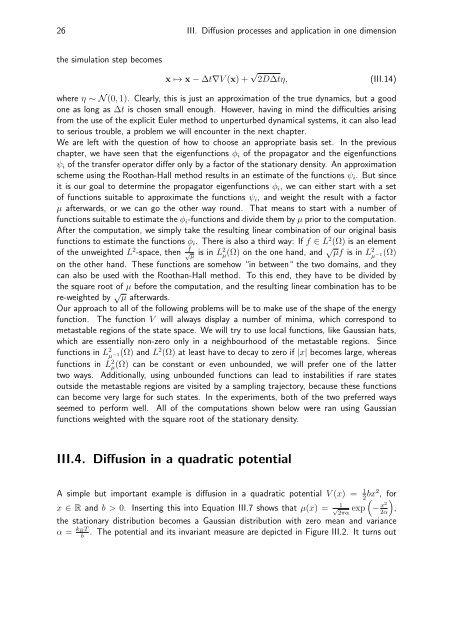Variational Principles in Conformation Dynamics - FU Berlin, FB MI
Variational Principles in Conformation Dynamics - FU Berlin, FB MI
Variational Principles in Conformation Dynamics - FU Berlin, FB MI
- No tags were found...
Create successful ePaper yourself
Turn your PDF publications into a flip-book with our unique Google optimized e-Paper software.
26 III. Diffusion processes and application <strong>in</strong> one dimensionthe simulation step becomesx → x − ∆t∇V (x)+ √ 2D∆tη,(III.14)where η ∼N(0, 1). Clearly,thisisjustanapproximationofthetruedynamics,butagoodone as long as ∆t is chosen small enough. However, hav<strong>in</strong>g <strong>in</strong> m<strong>in</strong>d the difficulties aris<strong>in</strong>gfrom the use of the explicit Euler method to unperturbed dynamical systems, it can also leadto serious trouble, a problem we will encounter <strong>in</strong> the next chapter.We are left with the question of how to choose an appropriate basis set. In the previouschapter, we have seen that the eigenfunctions φ i of the propagator and the eigenfunctionsψ i of the transfer operator differ only by a factor of the stationary density. An approximationscheme us<strong>in</strong>g the Roothan-Hall method results <strong>in</strong> an estimate of the functions ψ i .Buts<strong>in</strong>ceit is our goal to determ<strong>in</strong>e the propagator eigenfunctions φ i ,wecaneitherstartwithasetof functions suitable to approximate the functions ψ i ,andweighttheresultwithafactorµ afterwards, or we can go the other way round. That means to start with a number offunctions suitable to estimate the φ i -functions and divide them by µ prior to the computation.After the computation, we simply take the result<strong>in</strong>g l<strong>in</strong>ear comb<strong>in</strong>ation of our orig<strong>in</strong>al basisfunctions to estimate the functions φ i .Thereisalsoathirdway:Iff ∈ L 2 (Ω) is an elementof the unweighted L 2 -space, then √ fµis <strong>in</strong> L 2 µ(Ω) on the one hand, and √ µf is <strong>in</strong> L 2 µ(Ω) −1on the other hand. These functions are somehow “<strong>in</strong> between“ the two doma<strong>in</strong>s, and theycan also be used with the Roothan-Hall method. To this end, they have to be divided bythe square root of µ before the computation, and the result<strong>in</strong>g l<strong>in</strong>ear comb<strong>in</strong>ation has to bere-weighted by √ µ afterwards.Our approach to all of the follow<strong>in</strong>g problems will be to make use of the shape of the energyfunction. The function V will always display a number of m<strong>in</strong>ima, which correspond tometastable regions of the state space. We will try to use local functions, like Gaussian hats,which are essentially non-zero only <strong>in</strong> a neighbourhood of the metastable regions. S<strong>in</strong>cefunctions <strong>in</strong> L 2 µ(Ω) and L 2 (Ω) at least have to decay to zero if |x| becomes large, whereas−1functions <strong>in</strong> L 2 µ(Ω) can be constant or even unbounded, we will prefer one of the lattertwo ways. Additionally, us<strong>in</strong>g unbounded functions can lead to <strong>in</strong>stabilities if rare statesoutside the metastable regions are visited by a sampl<strong>in</strong>g trajectory, because these functionscan become very large for such states. In the experiments, both of the two preferred waysseemed to perform well. All of the computations shown below were ran us<strong>in</strong>g Gaussianfunctions weighted with the square root of the stationary density.III.4. Diffusion <strong>in</strong> a quadratic potentialAsimplebutimportantexampleisdiffusion<strong>in</strong>aquadraticpotentialV (x) = 1 2bx2 , forx ∈ R and b>0. Insert<strong>in</strong>g this <strong>in</strong>to Equation III.7 shows that µ(x) = √ 12παexp ,the stationary distribution becomes a Gaussian distribution with zero mean and varianceα = k BT. The potential and its <strong>in</strong>variant measure are depicted <strong>in</strong> Figure III.2. It turns outb− x22α









